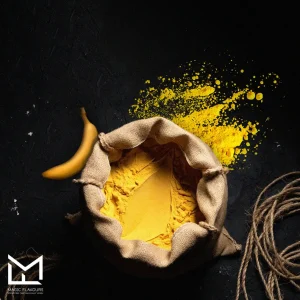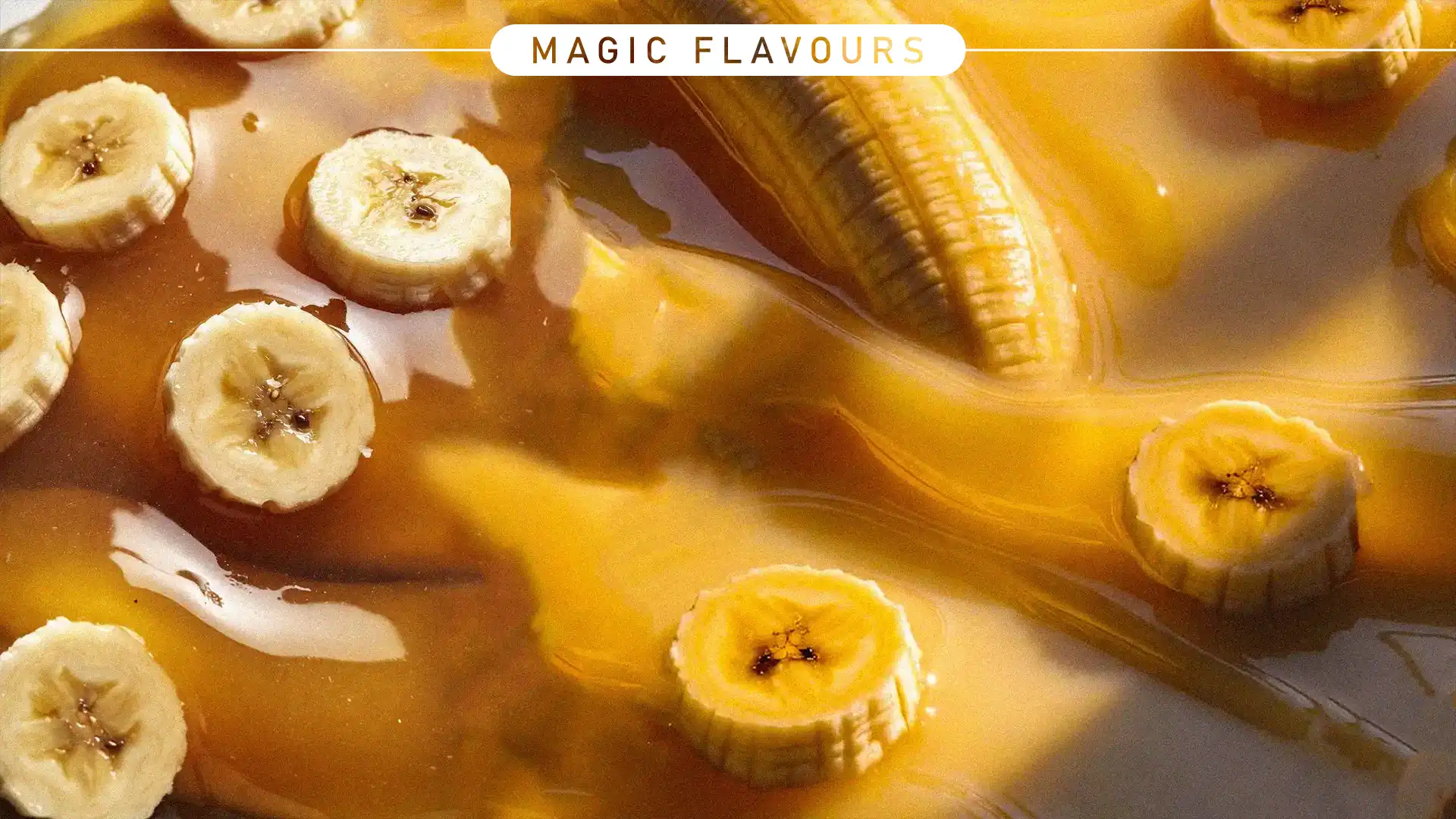1. Introduction to Banana Extract
What is Banana Extract?

Banana extract is a concentrated flavoring derived from natural or artificial sources. Additionally, it ensures a consistent taste in various products.
Furthermore, this extract allows manufacturers to replicate banana flavor in bakery, beverages, and desserts. It provides the signature aroma and sweetness.
Moreover, this extract is more stable than homemade versions. It maintains flavor during storage and transportation.
Differences Between Banana Extract and Homemade Extract
This extract differs from homemade extract in concentration and stability. Additionally, it provides a uniform flavor across all batches.
Furthermore, this extract is tested for consistency and quality, unlike homemade extract, which may vary by batch.
Moreover, this extract has a longer shelf life and withstands heat and processing. Homemade extract may lose flavor quickly.
2. Production of Banana Extract
Raw Materials Used in Banana Extract
This extract is made from ripe bananas or banana derivatives. Additionally, alcohol or glycerin is commonly used as a solvent.
Furthermore, some recipes include sugar or natural stabilizers to enhance flavor and shelf life. These ensure the extract remains consistent.
Moreover, high-quality raw materials are essential for a strong and authentic banana taste. Lower-quality bananas can affect aroma and sweetness.
Extraction Methods (Solvent Extraction, Alcohol-Based, or Glycerin-Based)
Banana extract can be produced using alcohol, glycerin, or solvent-based methods. Additionally, each method affects flavor intensity differently.
Furthermore, alcohol-based extraction is common for bakery and beverage applications. It preserves aroma and ensures long shelf life.
Moreover, glycerin-based extracts are less volatile and more suitable for heat-sensitive recipes. Solvent extraction is used for concentrated flavors.
Concentration and Standardization for Consistent Flavor
This extract is concentrated to ensure flavor strength and uniformity. Additionally, standardization prevents variation between batches.
Furthermore, quality control ensures aroma, sweetness, and stability meet product specifications. This is critical for large-scale production.
Moreover, standardized this extract allows manufacturers to predict flavor performance in recipes reliably. It reduces waste and maintains brand consistency.
3. Quality Control and Standards
Regulatory Compliance (FDA, EFSA, etc.)
Banana extract must comply with food safety regulations worldwide. Additionally, agencies like FDA and EFSA set strict guidelines.
Furthermore, compliance includes ingredient approval, labeling accuracy, and safe manufacturing practices. This protects consumers and brands.
Moreover, regulatory adherence builds trust and ensures products can be sold in multiple markets without legal issues.
Testing for Purity, Flavor Consistency, and Shelf Life
Banana extract undergoes testing to ensure purity and consistency. Additionally, flavor tests confirm aroma, sweetness, and overall quality.
Furthermore, stability testing evaluates how the extract performs over time under various conditions. This ensures long shelf life.
Moreover, quality testing prevents defective batches from reaching consumers. It maintains product reputation and customer satisfaction.
Packaging and Storage Requirements
This extract is stored in airtight, dark containers to preserve flavor. Additionally, cool temperatures reduce degradation risks.
Furthermore, proper packaging prevents contamination and maintains aroma during transportation. This ensures product integrity.
Moreover, standardized storage practices help manufacturers deliver consistent quality across batches and distribution channels.
4. Types of Banana Extract
Natural Banana Extract (from real fruit)
Natural extract is derived directly from ripe bananas. Additionally, it captures the authentic aroma and taste of the fruit.
Furthermore, it is preferred for clean-label products where natural ingredients are a priority. This appeals to health-conscious consumers.
Moreover, natural extract may vary slightly by batch due to differences in banana ripeness and variety.
Artificial Banana Flavor (synthetic compounds)

Artificial extract is made from synthetic compounds mimicking natural banana taste. Additionally, it offers consistent flavor across batches.
Furthermore, it is often more cost-effective than natural extracts. Manufacturers can scale production without seasonal constraints.
Moreover, artificial extracts allow experimentation with bold or unusual banana flavors not possible with natural fruit.
Blended Extracts (combining natural and artificial for stability)
Blended extract combines natural and artificial ingredients. Additionally, this balances authenticity with consistency.
Furthermore, blended extracts ensure flavor stability in heat-processed or long-shelf-life products. This is ideal for beverages and baked goods.
Moreover, blending allows manufacturers to control cost while maintaining a natural taste profile attractive to consumers.
5. Applications of Banana Extract
In Bakery and Confectionery
Banana extract is widely used in cakes, cookies, and pastries. Additionally, it enhances flavor without adding moisture.
Furthermore, it blends well with chocolate, vanilla, and other fruit flavors. This creates a balanced and appealing taste.
Moreover, this extract allows manufacturers to produce consistent flavor across multiple bakery batches.
In Beverages and Smoothies

Banana extract is added to juices, smoothies, and flavored drinks. Additionally, it provides natural sweetness and aroma.
Furthermore, it mixes easily with dairy or plant-based beverages without altering texture. This ensures smooth consistency.
Moreover, this extract helps create signature beverages that stand out in competitive markets.
In Dairy Products and Desserts
Banana extract is used in ice cream, yogurt, and custards. Additionally, it enhances fruit flavor without adding artificial coloring.
Furthermore, it maintains stability during freezing or cooking, preserving aroma and sweetness.
Moreover, this extract improves consumer appeal while maintaining quality and consistency in dairy desserts.
Flavoring in Snacks and Processed Foods
Banana extract flavors cereals, candies, and snack bars. Additionally, it delivers natural flavor without bulk.
Furthermore, it allows manufacturers to innovate with unique banana-flavored snacks.
Moreover, it ensures uniform taste in large-scale production and packaged goods.
6. Industry Trends and Innovations
Demand for Natural and Clean-Label Extracts
This extract with natural ingredients is increasingly popular. Additionally, consumers seek transparency and simple labeling.
Furthermore, clean-label products attract health-conscious buyers and increase brand trust.
Moreover, manufacturers are reformulating products to replace artificial additives with natural extract.
Sustainability in Ingredient Sourcing
Sustainable banana extract sourcing reduces environmental impact. Additionally, it meets consumer expectations for eco-friendly practices.
Furthermore, responsibly harvested bananas support ethical supply chains and fair trade initiatives.
Moreover, sustainable practices enhance brand image and meet regulatory requirements in global markets.
New Techniques for Flavor Enhancement and Stability
Innovative techniques improve extract flavor and shelf life. Additionally, microencapsulation and blending enhance aroma retention.
Furthermore, technology allows stable extracts for high-heat processing or long storage.
Moreover, new methods help manufacturers deliver consistent flavor in diverse products worldwide.
7. Challenges in Banana Extract Production
Maintaining Consistency Across Batches
Banana extract can vary in flavor due to differences in raw bananas. Additionally, consistency is crucial for brand reliability.
Furthermore, manufacturers use standardization techniques to ensure aroma, sweetness, and concentration remain uniform.
Moreover, quality control prevents flavor deviations that could affect consumer trust and product reputation.
Cost of Raw Materials vs. Market Price
High-quality bananas can be expensive. Additionally, fluctuations in supply affect the cost of extract.
Furthermore, manufacturers must balance ingredient costs with market pricing to remain profitable.
Moreover, efficient sourcing and bulk processing help manage expenses while maintaining extract quality.
Meeting Regulatory and Consumer Expectations
Banana extract must comply with local and international food regulations. Additionally, labeling accuracy and ingredient safety are mandatory.
Furthermore, consumers increasingly demand natural, ethically sourced extracts. This adds pressure on manufacturers.
Moreover, meeting both regulatory and consumer standards ensures market acceptance and long-term business success.
8. Conclusion
Key Takeaways About Banana Extract
This extract adds versatile flavor to bakery items, beverages, and desserts. Additionally, it provides consistent taste across products.
Furthermore, different types—natural, artificial, or blended—offer flexibility for manufacturers.
Moreover, proper production, extraction, and quality control ensure stable aroma, sweetness, and shelf life.
The Role of Banana Extract in the Food and Beverage Industry
This extract plays a vital role in product innovation and flavor development. Additionally, it helps brands meet consumer preferences.
Furthermore, trends in natural ingredients, sustainability, and clean-label products drive its growing demand.
Moreover, manufacturers that produce high-quality extract support consistent taste, brand loyalty, and global market success.
